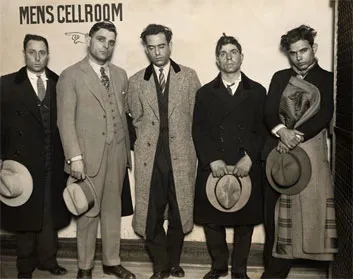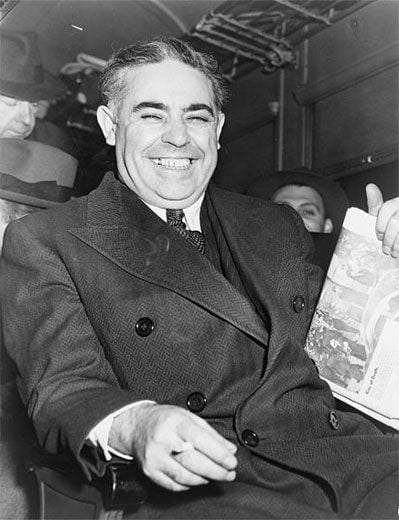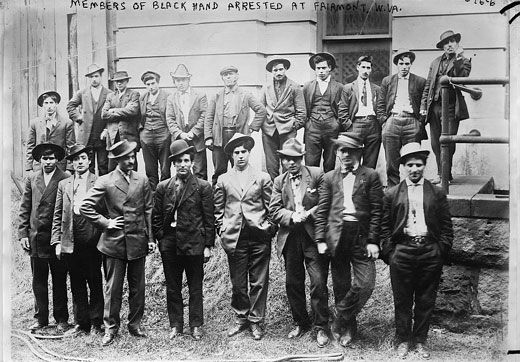Talking to the Feds
The chief of the FBI’s organized crime unit on the history of La Cosa Nostra
The final season of "The Sopranos" begins April 8. But don't count the bureau's Matt Heron among the millions of viewers—he's seen enough in his 20 years on the beat. Instead, Heron tells Smithsonian.com about the mafia's rise to power, its most influential character and its first big rat.
Why did La Cosa Nostra come over from Sicily?
It started in the early days as a strictly Italian thing, a Sicilian thing. Over time that morphed into the term "mafia," a Sicilian term that has since become generic, like Xerox. They started coming over into this country in the latter part of the 19th century, in the 1880s or so. The first indication I'm aware of was down in New Orleans. Everyone thinks it's New York, but it wasn't.
Why did they come over to this country from Sicily? One, to escape economic hard times in Italy. Also, to get away from the oppression being forced on them by the ruling government in Rome. Sicily is one of the most conquered pieces of land on the face of the earth. Consequently, it's a mixed bag of cultural influences. Sicily for the longest time was looked upon as the red-headed stepchild of Italy, especially once Mussolini came to power. The concern was keeping the Sicilian mafia under control, so lots of guys said "we're out of here."
What were some of the early gangs in America?
The original Black Hand gang is what later became known as La Cosa Nostra. They populated themselves in the ethnic Italian neighborhoods in New York. There was also the Five Points gang. The five points is in the fringes of Little Italy in New York. There's an intersection where five streets come together.
In the late 1920s, early 30s, you had fierce competition in New York among rival Italian enterprises for control. In terms of influential people, one of the most in that time—and maybe all time—was Lucky Luciano. Lucky Luciano was a master organizer. He set up La Cosa Nostra in this country as we still know it today, with five families and the ruling Commission. He formed alliances with other enterprises, such as the Jewish mob. He was very close friends with Meyer Lansky, the preeminent Jewish gangster in New York during that time. Lucky Luciano basically did away with the title "Boss of Bosses." There was no single individual who ran the whole show.
How did they come to power?
Their influences reigned in ethnic neighborhoods. Over time they branched out into other parts, as their power and influence grew. They moved from preying on their own ethnic community to preying on the community at large.
There were some watershed moments in this country that facilitated them, the most significant of which was Prohibition. It's all a matter of supply and demand. There's a demand for what they have to offer, and as long as that's there, they'll find a way to supply it. The 18th Amendment to the Constitution outlawed the manufacture and distribution of alcohol in the United States, but it did nothing with regard to demand for alcohol. People still wanted their liquor, and since it was no longer acquired legally at that time, here was a rich environment, an opportunity for these criminal enterprises to take advantage of the situation and satisfy the demand. And enrich themselves.
When people hear Prohibition they think Al Capone. What made him such a memorable gangster?
Capone was a New Yorker. He got transferred to Chicago to work under the offices of the leading gangster out there, Johnny Torrio. Capone was a muscle guy, an enforcer in New York. When Torrio got killed, that created Al Capone's moment of opportunity.
He was not unlike John Gotti, in the sense that he was a flashy person. He was also very vicious and violent. It was, as the saying goes, his way or the highway. The Mustache Petes, early-on gangsters, kept low profiles. They didn't do anything to draw attention to themselves. Capone, like Gotti, liked the spotlight.
How has organized crime changed since that time?
Once Prohibition was over, the sphere of influence had moved out of Italian neighborhoods and moved into society. At the end of the day, enterprises exist to generate revenue. They dealt in narcotics; they controlled labor unions, politicians. There are plenty of people out there who want something, and these guys want to facilitate that.
The structure of La Cosa Nostra has not changed since the 1930s, when Lucky Luciano established the framework. As new people came in to run families, they take on the name of that individual. Joe Bonanno's group became the Bonanno family; Carlo Gambino's group became the Gambinos. Vito Genovese gave his name to the family he controlled. The names have changed, but the structure has been steady over the last 75 years.
How powerful is it today?
La Cosa Nostra, in various forms, has existed for over 100 years. The government, authorities, FBI, prosecutors didn't start to make a significant impact on La Cosa Nostra until the late 70s, early 1980s.
At one point, La Cosa Nostra wasn't thought to exist. It was a myth, a legend. That was until 1957, with the Appalachian meeting in upstate New York. That was a big meeting where the heads of all the families got together for a strategy session. They were discovered by New York state troopers. It's a famous story in the history of organized crime. You had mob bosses trying to make a break through the woods. It forced people to acknowledge that, yes, there is La Cosa Nostra in this country. It does exist.
What's RICO?
The one single event that did more than anything to curb organized crime was the passage of the RICO statutes in 1970. RICO being the Racketeer Influenced and Corrupt Organizations Act. It passed in 1970 but wasn't implemented until the late 70s, early 80s. That's when we started seeing the huge success against La Cosa Nostra that we've seen in last 25 years.
In the past, you'd prosecute a mobster for extortion or loan sharking. That might carry a three-year sentence. To these guys, that's nothing. They would go away, do time, their families would be taken care of, they'd come out and do what they wanted to do again. RICO took predicate acts, certain crimes, and instead of prosecuting them for individual acts, such as extortion, you lumped them under a racketeering statute. What happens then, when you start prosecuting folks, that 3- to 5-year sentence becomes 25 years. With multiple counts, it's 100 years in prison.
In the mid 80s, with the Commission case, the major players in the New York underworld all received 100-year sentences. These guys were in their 60s and 70s at the time. People started to make deals for themselves by cooperating. Then you had mobsters turning on other mobsters. It was an opportunity for us to exploit that situation to our advantage.
Before that time, did mobsters ever talk to the FBI?
It was rare 50 years ago. In 1963, Joe Valachi, a Genovese soldier, was doing time in a federal prison in Atlanta, as was Vito Genovese. It got back to Joe that Genovese wanted him killed. So Joe sees an inmate come up to him in prison one day. Thinking it's Vito's guy coming to whack him, he picked up a lead pipe and beats him to death. Turns out it was just some other inmate. Now he's facing a death sentence, and decides to talk. He's the first really significant cooperator to come forward.
Other than that, it was rare to have a made guy talk. In La Cosa Nostra, you have made people and associates. In order to be fully made, you have to be Italian, Sicilian and male. Associates were basically anybody else—anyone who could generate money for the enterprise. We didn't really have made guys talking until the late 70s, early 80s, when big cases started to break. The Commission case, the Donnie Brasco case. The infiltration of the Bonanno family by Joe Pistone, an undercover FBI agent, was the first ever penetration of an organized crime family by the bureau. It became known as Donnie Brasco. That gave us inroads we hadn't had. All those things happened in the same period of time. These guys were looking at huge terms in jail, thinking I gotta do what I can.
What's the status of La Cosa Nostra?
Are they wounded? Yes. Are they dead? No. Will they ever be dead? I don't think so. It goes back to what I said at the outset: There's too much of a demand out there for things they can provide.
What figure interests you most?
Carlo Gambino, the head of the Gambino family. He was different in that he died at home in bed, just stopped breathing one day. He was succeeded by son-in-law, Paul Castellano, who was helped to his great reward by John Gotti, who took over the Gambino family. The contrast between Gambino and Gotti was huge. Gambino led a nondescript existence, had no big mansion, didn't draw attention to himself running around town with girlfriends. At the other end of the spectrum was John Gotti, who started to believe his own press.
If I had to pick one person who was the most influential La Cosa Nostra figure in this country, though, it would have to be Lucky Luciano.
Do movies portray the organized crime world accurately?
One of the best movies I ever saw was The Godfather. I say that because it was well done, but it also was bad in the sense that it humanized these people, and glamorized them. I think since them there's a tendency in movies and the press to shine a sympathetic light on these guys.
Why is the public so fascinated by mobsters?
The portrayals in TV and books have turned these criminals into celebrities, into having a cult-like status. The inclination in this country is to look positively towards someone with celebrity status. Some of these guys played into that.
I've known a lot of these people over the years. Some of the guys in the Commission. "Fat Tony" Salerno. Lefty Ruggiero, who was played by Al Pacino in the movie Donnie Brasco. You get to talking to them, and they can be very engaging. But you have to remember who they are, and what they represent.
Do you watch "The Sopranos"?
No. I've never watched it. I've lived and breathed this stuff for 20 years, and I don't feel the need to watch it.
/https://tf-cmsv2-smithsonianmag-media.s3.amazonaws.com/accounts/headshot/eric-jaffe-240.jpg)



/https://tf-cmsv2-smithsonianmag-media.s3.amazonaws.com/accounts/headshot/eric-jaffe-240.jpg)